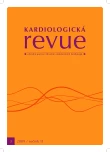Coronary events and inflammation.
Authors:
V. Staněk
Authors‘ workplace:
Klinika kardiologie IKEM, Praha
Published in:
Kardiol Rev Int Med 2009, 11(3): 139-142
Category:
Nontraditional risk factors cardiovascular disease
Overview
Traditionally, identification of persons in risk of myocardial infarction is based on the evaluation of the established risk factors, i.e. smoking, hypertension, hyperlipidaemia and diabetes. However, half of the patients with myocardial infarction have a maximum of one risk factor and there is an urge to further specify the risk of an event. At present, atherosclerosis, development of an atheroma as well as development of plate rupture are considered to be inflammatory processes. Activated immune cells produce cytokines that are detectable either directly from blood or as systemic manifestations. These indicators, inflammation markers, are now identified as other risk factors of a coronary or cerebral event. Of all these biomarkers, C‑reactive protein (high‑sensitivity CRP – hs CRP) and lipoprotein‑associated phospholipase (Lp/PLA2) are most researched. The presence of these inflammatory biomarkers increases the risk evaluated with the traditional risk factors about two‑fold. Even though the current guidelines do not include these biomarkers in the risk calculation, evidence exists suggesting that higher values of these biomarkers might represent an indication for an intensive hypolipidemic therapy even in situations when this would not be indicated based on the traditional risk calculation. Monitoring of the inflammatory markers represents a move from the traditional risk identification to identification of activation of vascular inflammatory processes; the move from identification of exercise‑induced myocardial ischemia to identification of vulnerable plates and a vulnerable patient.
Keywords:
atherosclerosis – risk factors – vulnerable plate – C‑reactive protein – lipoprotein‑associated phospholipase A2
Sources
1. Ross R. Atherosclerosis – an inflammatory disease. N Engl J Med 1999; 340 : 115–126.
2. Ridker PM, Cushman M, Stampfer MJ et al. Inflammation, aspirin, and the risk of cardiovascular disease in apparently healthy men. N Engl J Med 1997; 336 : 973–979.
3. Ridker PM, Hennekens CH, Buring JE et al. C‑reactive protein and other markers of inflammation in the prediction of cardiovascular disease in women. N Engl J Med 2000; 342 : 836–843.
4. Zieske AW, Tracy RP, McMahan CA et al. Pathobiological Determinants of Atherosclerosis in Youth Research Group. Elevated serum C‑reactive protein levels and advanced atherosclerosis in youth. Arterioscler Tromb Vasc Biol 2005; 25 : 1237–1243.
5. Ridker PM, Rifai N, Pfeffer MA et al. Inflammation, pravastatin, and the risk of coronary events after myocardial infarction in patiens with average cholesterol levels. Cholesterol and Recurrent Events (CARE) Investigators. Circulation 1998; 98 : 839–844.
6. Nissen SE, Tuzcu EM, Schoenhagen P et al. REVERSAL Investigators. Effect of intensive compared with moderate lipid-lowering therapy on progression on coronary atherosclerosis: a randomised controlled trial. JAMA 2004; 291 : 1071–1080.
7. Gami AS, Witt BJ, Howard DE et al. Metabolic syndrome and risk of incident cardiovascular events and death: A systematic review and meta‑analysis of longitudinal studies. J Am Coll Cardiol 2007; 49 : 403–414.
8. Zacho J, Tybjaerg-Hansen A, Jensen JS et al. Genetically elevated C‑reactive protein and ischemic vascular disease. N Engl J Med 2008; 359 : 1897–1908.
9. Ridker PM, Danielson E, Fonseca FA et al. Rosuvastatin to Prevent Vascular Events in Men and Women with Elevated C-Reactive Protein (JUPITER Study). N Engl J Med 2008; 359 : 2195–2207.
10. Lerman A, McConnell JP. Lipoprotein‑associated phospholipase A2: A risk marker or a risk factor? Am J Cardiol 2008; 101 (Suppl): 11F–22F.
11. Packard CJ, O’Reilly DSJ, Caslake MJ et al for the West of Scotland coronary prevention study group. Lipoprotein‑associated phospholipase A2 as an independent predictor of coronary heart disease. N Engl J Med 2000; 343 : 1148–1155.
12. Anderson JL. Lipoprotein‑associated phospholipase A2: An independent predictor of coronary Artery disease events in primary and secondary prevention. Am J Cardiol 2008; 101 (Suppl): 23F–33F.
13. May HT, Horne BD, Anderson JL et al. Lipoprotein‑associated phospholipase A2 independently predicts the angiographic diagnosis of coronary artery disease and coronary death. Am Heart J 2006; 152 : 997–1003.
14. Gorelick PB. Lipoprotein‑associated phospholipase A2 and risk of stroke. Am J Cardiol 2008; 101 (Suppl): 34F–40F.
15. Davidson MH, Corson MA, Alberts MJ et al. Concensus panel recommendation for incorporating lipoproteid‑associated phospholipase A2 testing into cardiovascular disease risk assessment guidelines. Am J Cardiol 2008; 101 (Suppl): 51F–57F.
Labels
Paediatric cardiology Internal medicine Cardiac surgery CardiologyArticle was published in
Cardiology Review

2009 Issue 3
Most read in this issue
- ECG monitoring with Holter monitor
- Current opinions about the role of mild hyperhomocysteinaemia as a risk factor of cardiovascular diseases
- Uric acid and cardiorenal risk
- HRT and cardi ovascular risk
